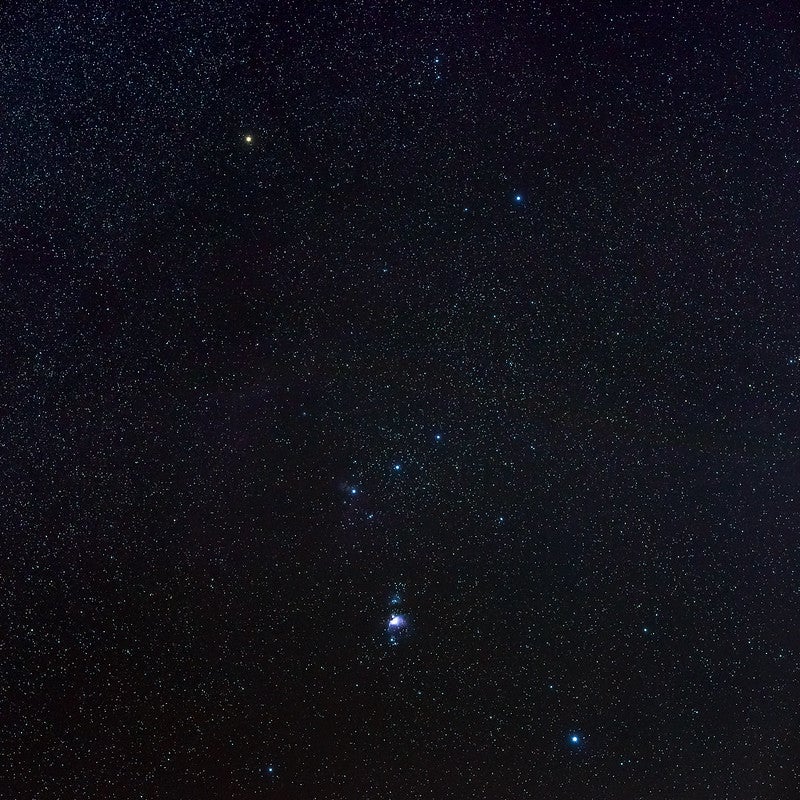
Lucky skywatchers in a narrow path across portions of Asia, Europe, and southern Florida will see an exciting sight tonight: For an instant, one of the most well-known stars in the sky will wink out.
The star is Betelgeuse, the red giant who anchors one shoulder of Orion the Hunter. And for those in the path, it will very briefly disappear for a matter of seconds when the main-belt asteroid 319 Leona passes in front of it in an event called an occultation.
What is an occultation?
An occultation occurs when a planet or asteroid in our solar system appears to pass in front of a more distant star from our point of view. This happens because nearby objects appear to move more — and more rapidly — than the distant stars. Occultations are an important way for astronomers to study our solar system, as exactly when and how the background starlight winks out is related to details such as the size and shape of the occulting object. It can even reveal previously unknown features, such as rings.
So, although it’s Betelgeuse that will disappear during the occultation, Leona is the real “star” of the show. By watching the way Betelgeuse disappears and reappears, as well as timing exactly how long the event takes, researchers will be able to better pin down the size and shape of Leona — a very tricky task, given that it’s small and dim and difficult to otherwise study.
But Betelgeuse may just reveal some secrets, too — the star appears so large even from Earth that we might be able to see features on its surface, such as convective cells.
When and where will Betelgeuse disappear?
Based on previous occultations, we know that Leona is roughly oblong and about 50 miles (80 kilometers) across at its widest. Depending on where an observer is in the path, Leona’s passage will block Betelgeuse for somewhere between 5 and 15 seconds.
Like eclipses, occultations occur only over narrow tracks determined by where the shadow of the planet or asteroid falls. This is similar to the way the shadow of the Moon passes over only some regions of Earth as it blocks out the Sun during a solar eclipse.
The path for this occultation runs from central Asia through Europe, then crosses the Atlantic to fall over southern Florida and part of Mexico. In the U.S., the path runs from northeast to southwest, covering the southern tip of Florida from just north of Fort Lauderdale to just south of Marco Island. The path also includes all of Key West, terminating just south of the island. The occultation will occur between about 8:24 P.M. and 8:26 P.M. EST for U.S. observers.
You can find an interactive map showing the path on the Occult Watcher Cloud website, which will allow you to click on any location within the path to find out when exactly it’s predicted to occur.
Note that the map gives the event “mid-time,” or the middle of the occultation. Again, the entire occultation will last only seconds, so if you’re in the path, make sure you are observing Betelgeuse at least several minutes before this time and note that the occultation will start at most some 7 seconds or so before the mid-time from your site.
If you aren’t in the path, don’t worry: The Virtual Telescope Project will livestream the event, beginning at 8 P.M. EST. You can watch the feed below.
A unique event
If you are in the path and looking up at the right time, Betelgeuse’s disappearance will be a unique and exciting sight to see. Occultations happen fairly often, but typically they affect dim stars and only astronomers notice. But Betelgeuse, at magnitude 0.7, is the 11th-brightest star in the sky, and a well-known one at that. You might remember that it snagged headlines in 2020, when it noticeably dimmed over the course of weeks before regaining its usual brightness. Researchers now think it may have “sneezed” out a cloud of plasma that subsequently cooled, blocking a portion of its light for a time.
This aging star will someday (though not imminently) go supernova, resulting in a spectacular show that will be visible from Earth — albeit some 600 years after the star actually explodes, given its distance and the time it will take the light from its death to reach us. But for now, it’s a famous and fabulous staple of our night sky and tonight, Betelgeuse offers its help to give us a peek at the tiny world Leona, much closer to home.









